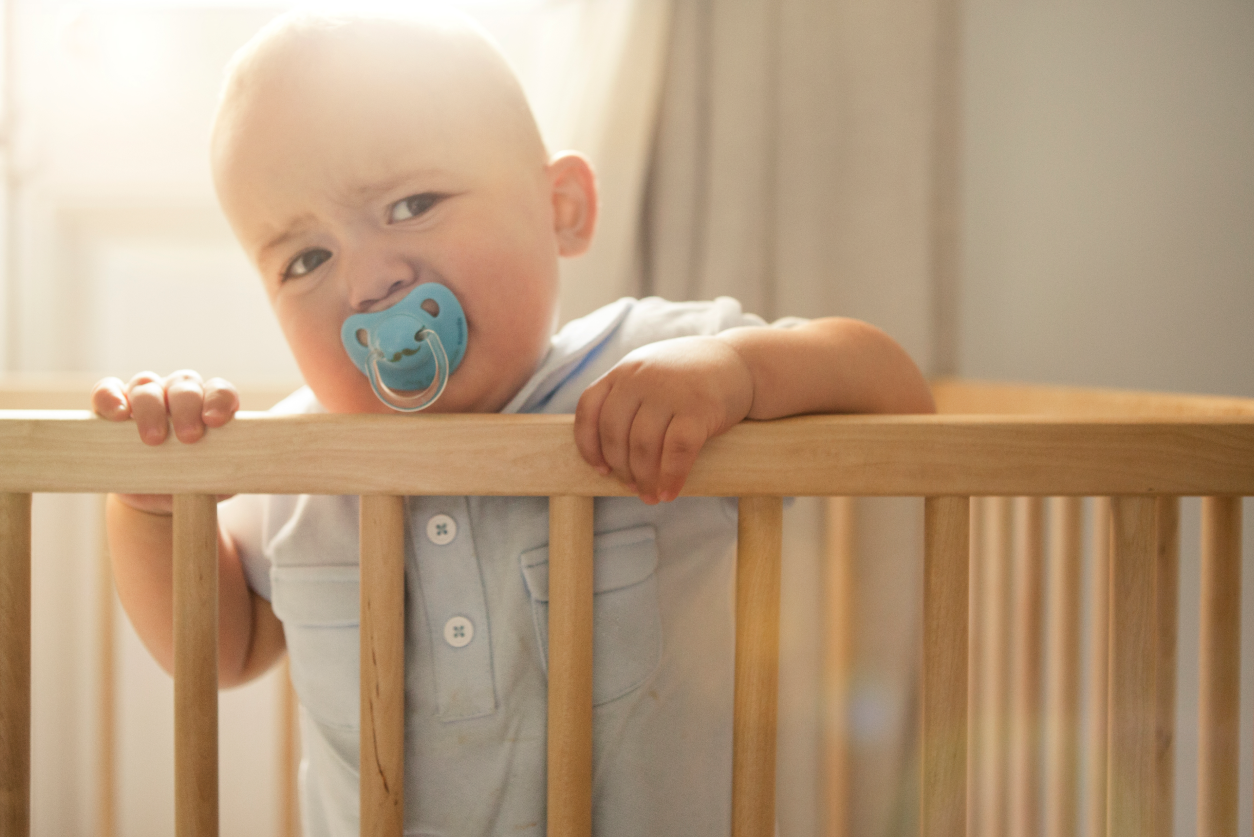Has this ever happened to you? Your little one is around 6 months of age, cuter than ever and growing by leaps and bounds every day. You turn to leave the nursery for a moment to get something from the kitchen. You get maybe three feet from the crib when your baby starts crying hysterically.
On the one hand, you’re delighted that your baby misses you (even from three feet away!). On the other hand, you might start to worry—what if your baby's anxiety means you’ll never be able to leave the house for the next 18 years without your child crying? For many parents, this stage is both heartwarming and challenging.
Rest assured, dear parent, you will be able to leave your house again. The culprit behind your little one’s behavior is most likely due to baby separation anxiety, a very normal part of baby’s emotional development and, thankfully, a temporary disruption.
So as a primary caregiver, what can you do about it? We talked to expert and sleep consultant Brooke Nalle of Sleepy on Hudson to get all the details on this important milestone and how it can affect your baby’s sleep.
First thing’s first, what is separation anxiety and when does it start in babies?
Separation anxiety refers to a developmental milestone that occurs in most young babies between 6 to 7 months of age, when they gain a sense of object permanence through the baby development process.
What is Object Permanence?
We know what you’re thinking. Object-perm-a-what ? It’s a fancy term that basically means your baby knows that objects and people – like yourself – exist even if they’re not in the room or close by. Separation anxiety happens as a direct result of this important new baby development.
“Before object permanence kicks in, you can put your child in the crib, walk away and if they cry it’s not necessarily because they miss you,” Brooke says. “This is a big milestone because now babies start to sense that when Mommy walks away, she’s sometimes gone for a long time, sometimes for five minutes.”
It’s the not knowing how long you’ll be gone for that causes distress, affects a baby’s sense of security, and makes them feel vulnerable. Hence the hysterical crying when you put the baby to bed, leave for work in the morning or drop them off at daycare. A strange environment or unknown caregiver can upset your baby and make separation anxiety worse. But, for the most part, there's no need to worry --- your baby will be okay once they feel secure again. “As soon as they feel safe and happy with wherever they are next, they’re fine,” Brooke says. “It’s just that transition moment.”
Both parents and primary caregivers can experience the side effects of baby separation anxiety, “There’s separation anxiety from the parent who takes care of the baby the most,” Brooke says. “It’s usually most amplified if you’re a breastfeeding mother.”
If separation anxiety is a milestone, does that mean it’s actually a good thing?
Yes! Separation anxiety is a sign that baby’s growing up. “When I hear families are going through this, I say congratulations,” Brooke says. “It’s such a big deal. It means that your baby understands you and feels connected to you, and that’s a good thing.”
If your baby’s anxiety seems extreme or interferes with daily activities, it may be worth consulting a pediatrician to rule out any underlying medical concerns.
When is separation anxiety most common and how long does it last?
Separation anxiety typically lasts for a short period within two to three weeks and can pop up throughout infancy and toddlerhood, as well as later in childhood. It’s a normal developmental stage that many kids go through as they grow. For babies under two years, it’s most common during the following ages:
- 6 to 7 months: Around this time, and sometimes earlier, many infants gain a sense of object permanence. This is a big milestone in cognitive development, but it can also trigger separation anxiety because your baby realizes that when you leave, you are gone, and they may not understand when you will return. Your baby may seem clingy and upset during separations, even for brief moments, as they adjust to this newfound awareness.
- 9 to 10 months: This is when your baby starts to have a much better sense of familiar faces and their daily routine. “Separation anxiety can flare up around this time as babies start to understand different social scenarios a bit more,” Brooke says. “They know, ‘Oh, I get dropped off in the morning at day care and Mom’s gone for a really long time.’” Babies this age can now grasp that you leave and come back, but they might not fully understand the concept of time, which can make separations feel much longer to them than they are. It's also around this time that babies begin to engage more in social interactions and become more sensitive to how their caregivers behave. As they gain more social awareness, they can experience emotional distress when they perceive a separation.
- 13 to 14 months: At this stage, your baby might have trouble expressing how they feel, which can lead to a resurgence of separation anxiety. “During the time, they have great receptive language, meaning they understand what you’re saying, but they can’t express how they feel,” Brooke says. “They want to say, ‘Why do you have to go to work? Why are you leaving me?’ But they can’t say that, so they cry.” This gap between understanding and communication can increase frustration and anxiety. Separation anxiety during this phase may be more intense, as your little one starts to understand the difference between you being nearby and you being absent for longer periods.
- 18 Months to 2 Years: Separation anxiety can resurface between 18 months and 2 years as toddlers experience a developmental leap in independence and social interaction. During this time, they may push boundaries and test limits, which can sometimes appear as defiance. While this is a sign of healthy growth and autonomy, it can also lead to feelings of insecurity, especially if there are changes in routine or environment. The emotional transition of separation can be challenging as toddlers navigate their growing independence alongside their need for comfort and security.
According to Brooke, separation anxiety will eventually ease once your baby gets the hang of a new milestone. She compares it to what happens when you start a new job. “It’s exciting to have a new job, but it doesn’t feel very comfortable,” Brooke says. “That’s how milestones can be for children. It’s a great thing, but they just don’t really know how to handle brief separation and they don’t feel comfortable. After a couple weeks, though, they’ll get it and relax.”
What does separation anxiety look like?
Signs of separation anxiety are rarely physical, Brooke says, and can include:
- Increased clinginess
- Crying when you leave a room, even for a short period of time
- Resistance to being put down to bed
- Increased nighttime wakeups
- Stranger anxiety, i.e. Grandma says, “Let me hold my grandson!” and as soon as you hand the baby over, he starts crying
How will you know if it’s separation anxiety and not something else?
Brooke’s test: pick your baby up. If you hold them and they stop crying, the cause of their tears most likely has to do with separation anxiety. If they continue crying, even after you pick them up, something else might be going on.
What can you do about separation anxiety?
It’s important to observe other symptoms and consult a pediatrician if you’re unsure. In the meantime, try to reassure your baby with soothing words and comfort to help them feel secure.
- Play peekaboo: This classic game of childhood can do wonders for separation anxiety, as can games like hide-the-ball. These types of activities help babies realize that things that go away come back. “I tell families dealing with separation anxiety to play lots of ‘hide an object, show it to them’ games,” Brooke says. “And play peekaboo tons!”
- Say what you mean, mean what you say: Babies are really, really good at sniffing out inconsistencies in your behavior (hey, they like to keep you on your toes!). When you say goodbye to your baby in the morning or goodnight to them in the evening, be sure to mean what you say. “If you say, ‘Bye-bye, love you!’ and walk out of the nursery, stay out, even if the baby cries,” Brooke advises. “If you go back in, you’re kind of teaching the baby not to look to anybody else for safety and security.”
- Don’t sneak out: Brooke cautions against escaping before your baby notices you’re gone. “It’s confusing to the child,” Brooke says. “All of a sudden you’re gone and that can actually cause more problems. It really helps to be upfront with children.”
- Narrate what’s happening: Talking kids through what’s going on can be useful, particularly for older children. “Make a very clear routine and say, ‘You’re going to give me three hugs when I put my coat on and that means goodbye,’” Brooke suggests. “When you walk out, say, ‘Remember, Mommy always comes back’ or ‘Daddy always comes home.’” This helps build trust and gives parents peace of mind as well.
- Prepare ahead of time: If you’re transitioning your baby 6 months of age and older to daycare or introducing another caregiver, like a nanny, it can be helpful to prepare slowly in advance – that way there are no surprises when transition time arrives. “There’s always an adjustment period, but if you can help phase it in a little bit that’s going to make things easier,” Brooke says. “For example, if you know you’re going back to work on May 1, have the nanny start on March 15 and come every morning for just a few hours.” Brooke points out that it can also be beneficial to start a major transition like daycare at 4 or 5 months, instead of later on, that way “you’re not starting right at the peak of separation anxiety.”
- Harness the power of smell: Your scent is comforting to your baby and can even help them through the uneasiness of separation anxiety. “Give them something that reminds them of you,” Brooke says. “A lot of parents will sleep with a lovey for a week so that it picks up their scent.”
- Alternate the bedtime routine: If one parent typically handles the bedtime routine and skips a night or two, the baby will likely notice their absence and respond with tears. “If possible, alternate the person who does bedtime or have both partners play some role in the routine,” Brooke says. “For example, maybe on weekends, your partner handles naptime or does bathtime at night since they’re home from work. That’ll give your family more flexibility.”
- Make the crib a happy place: It’s important that your baby gets to know their crib and views it as a happy place. That way they feel secure there, even in situations when you leave them there momentarily or they wake up in the middle of the night on their own. Brooke calls it positive crib acclimation. “The more positive experiences you have in the nursery the better,” she says. “Attend to or play with your baby while they’re happy in the crib and take them out of the crib while they’re still happy.” You can also use a baby smart monitor camera like the Nanit Pro Camera to watch your baby and use two-way audio to speak to your baby. Or use the a night light sound machine like the Nanit Sound + Light to reduce stress and help your little one feel at ease.
- Keep calm: Last but not least, try to keep your cool. “Remember that babies mirror their parents’ faces and reactions and actions,” Brooke says. “If they start crying when you leave and you freak out, your baby’s going to kind of pick up on that. Be calm and just say, ‘It’s okay, I’ll see you later, bye-bye.’”
A quick note about baby sleep training…
By 6 months, many infants can start sleeping through the night without waking to feed, and a lot of families choose to sleep train then. That’s right around the time separation anxiety appears, though. So, if you do decide to sleep train, you might want to do so earlier around 4 or 5 months.
“You can still sleep train even if there’s separation anxiety,” Brooke says. “But you might get a little more drama when you walk out of the room than you would with a 4-month-old.”
Want to know more about how developmental milestones can affect sleep? Check out our breakdown of common sleep disruptors and what to do about them here.
Looking for more help? Find advice and tips from parents like you in our community.
Key Takeaways
- Remember that separation anxiety is a normal phase of development, often starting around 6-7 months, It's an indicator of your child's growing awareness and emotional connection. For kids and toddlers, it’s a healthy sign of attachment, but it can also be challenging for parents to navigate.
- Try to address signs early when you start to recognize symptoms like increased clinginess or bedtime resistance. Engage in activities that reassure your baby about your return to help your child foster a sense of security and comfort
- Some strategies to help include: Maintain consistency in goodbyes, avoid sneaking out, and ease into caretaker transitions slowly whenever possible. Create positive associations with the crib and consider encouraging your baby to sleep independently before the 6-month mark.








































